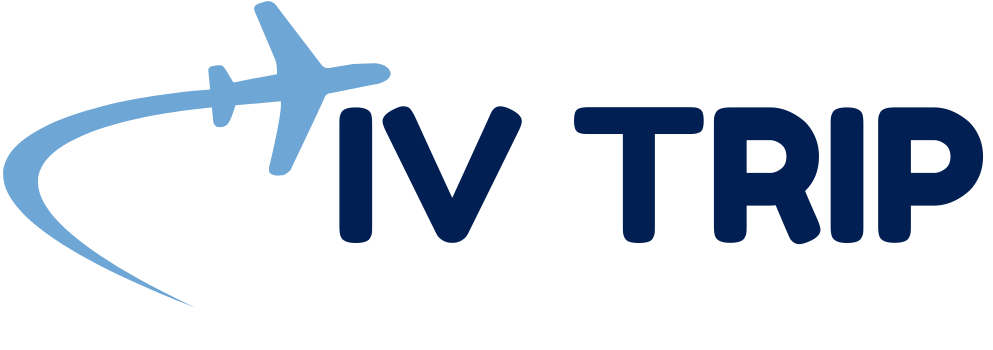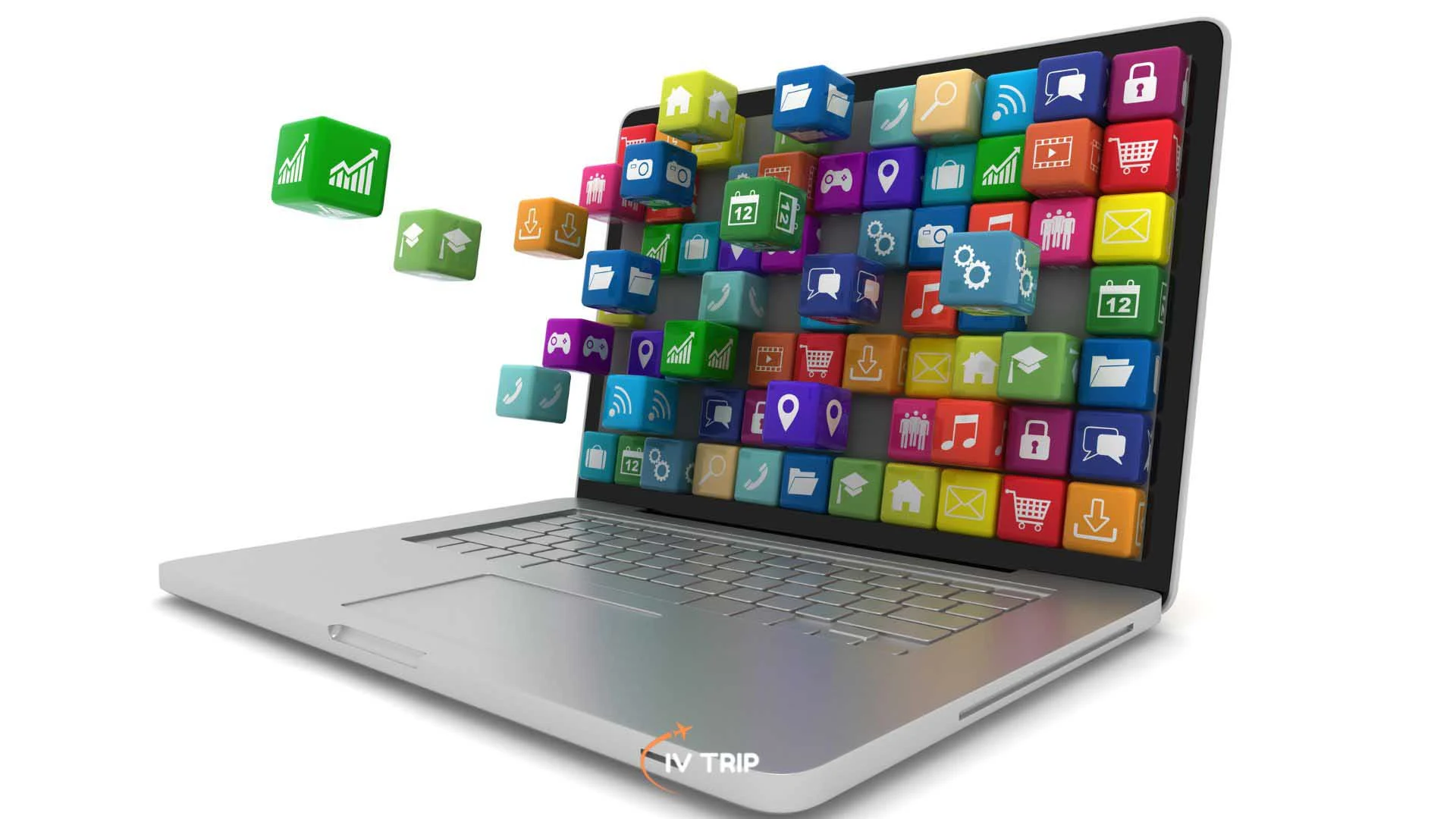How to Start an Online Travel Agency (OTA) with IVTrip
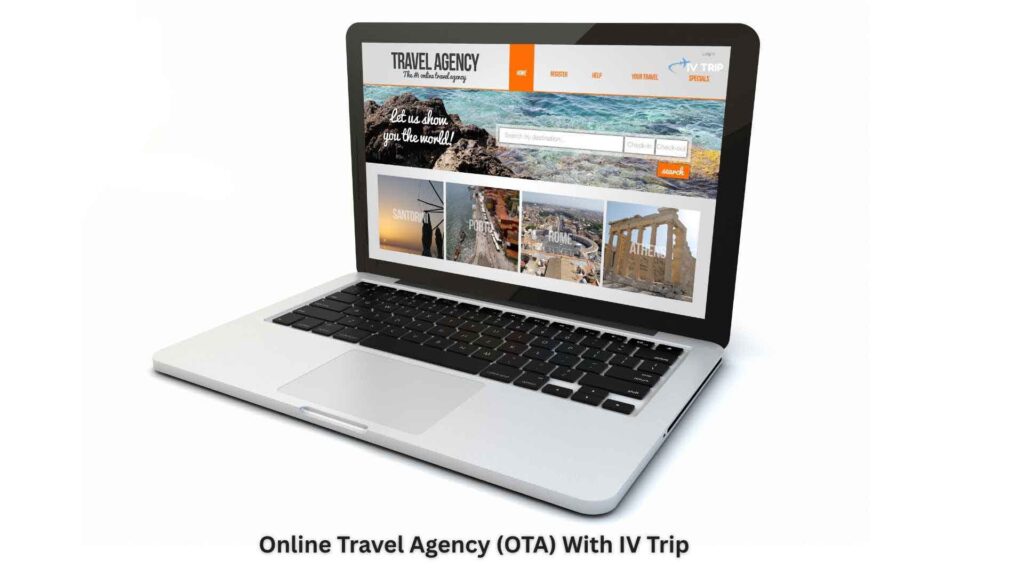
Starting an Online Travel Agency (OTA) means building a web-based portal where travelers can book flights, hotels, tours, and more. In today’s market, an OTA must integrate real-time inventory, secure payments, marketing automation, and CRM tools. IV Trip by Implevista is a cloud-based travel management system that bundles all these features.
It lets you launch an OTA portal quickly without building everything from scratch. In this guide, we’ll walk through each step of planning, setting up your IV Trip OTA portal, connecting live inventory (flights/hotels), enabling payments, and leveraging marketing and CRM automation. By the end, you’ll know exactly how to launch and grow your online travel agency portal with IV Trip’s platform.
What Is an Online Travel Agency (OTA)?
An Online Travel Agency (OTA) is a website or app that lets customers book travel services online. OTAs typically offer flight reservations, hotel bookings, tours, and package deals all in one place. In essence, an OTA is “an online platform that offers flight bookings, hotel reservations, tour bookings, or any other travel-related service online”.
Unlike a traditional travel agency, everything happens digitally – customers search and book on a website, and confirmations arrive instantly. OTAs make travel planning easier for users (one-stop shopping for travel) and open new sales channels for agencies. As digital travel grows, launching an OTA can capture a large share of travelers who prefer booking online.
Key facts underscore why online portals are critical: over 60% of travelers in Bangladesh already prefer booking online, and a staggering 85% of OTA bookings are made via mobile devices. This means your OTA needs to be mobile-friendly.
IV Trip’s platform is fully responsive for smartphones and tablets, so customers can manage their bookings on any device. In short, an OTA combines all travel inventory and services in one system. With IV Trip, you get a ready-made, cloud-based OTA engine that handles bookings, payments, and customer management – all in one place.
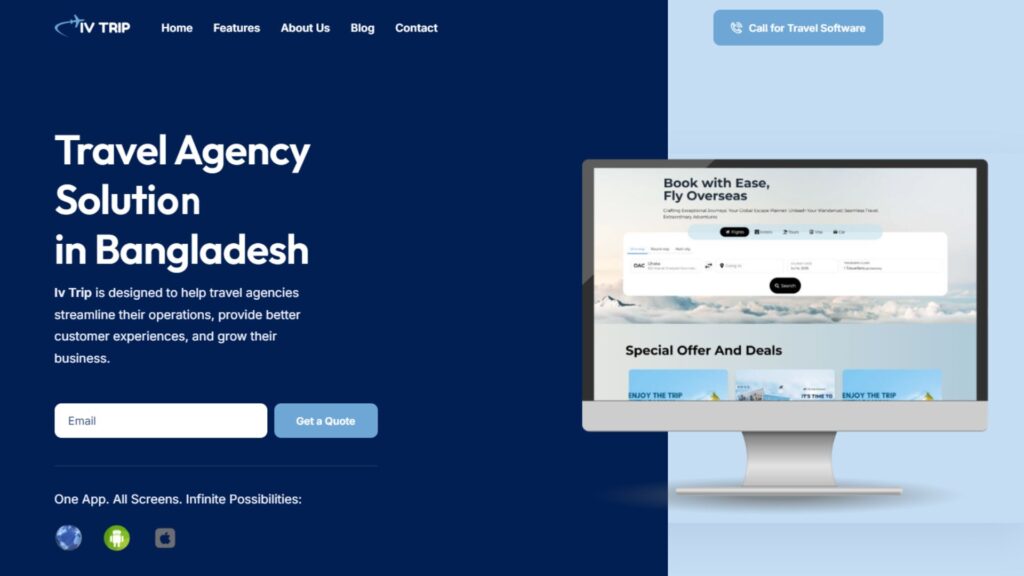
Why IV Trip for Your OTA?
Choosing the right software is crucial. IV Trip is designed specifically for travel agencies in Bangladesh and South Asia, so it matches local needs. It’s an all-in-one cloud platform combining booking engines (flights, hotels, tours), CRM, finance, marketing automation, and analytics. Because IV Trip is SaaS-hosted, there are no on-site servers to manage. Updates happen centrally, and you instantly get improvements.
The system’s user interface is fully mobile-responsive, meaning both agents and customers can use it on phones or tablets just as easily as on a PC.
Integrated GDS and APIs: IV Trip connects to global distribution systems (GDS) like Amadeus, Sabre, Travelport and even local airlines via XML/JSON APIs. This means you access real-time flight schedules, seat availability, hotel rooms, and tour inventory directly. The software “interfaces with global content” so agents see live rates from airlines, hotels and tour suppliers. In practice, when a customer searches for a flight or hotel on your OTA site, IV Trip will query these external systems and show up-to-date availability and pricing.
Built-in CRM and Automation: A modern travel agency needs CRM to track customers and leads. IV Trip has a robust CRM module that logs every interaction (queries, bookings, preferences). It can auto-segment clients (e.g. business vs. leisure travelers) and trigger targeted email campaigns. Routine tasks like sending invoices or post-trip follow-ups are automated, so nothing slips through the cracks. According to one satisfied agency owner, IV Trip “covers every aspect of our travel business – CRM, invoicing, bookings, and reporting” in one platform. This all-in-one approach means you won’t juggle multiple tools. You get analytics dashboards to spot your best-selling packages, monthly revenue trends, and more.
Local Support and Affordability: IV Trip is backed by local Bangladeshi support. You get 24/7 help and training resources from Implevista’s team. Because the pricing is tailored for the region, even small agencies can afford top features. IV Trip offers tiered subscription plans for different agency sizes, and it uses local currency (BDT) pricing to keep costs reasonable. In short, IV Trip bundles everything an OTA needs in one package – from real-time inventory to CRM and marketing – with local service and competitive pricing.
Step 1: Plan Your OTA Business
Before launching the website, you need a solid plan. Treat it like starting any business. Begin with market research and legal steps, then build your brand.
- Define Your Niche and Name: Decide what market your OTA will target. Will you focus on budget travelers, luxury tours, corporate clients, or a specific region? Choose a unique, travel-related business name that resonates with your audience. For example, if you specialize in eco-tourism, your name and branding should reflect sustainability. A strong brand helps you stand out.
- Legal Structure and Registration: Select a business structure (sole proprietorship, LLC, etc.) and register your company. Obtain any necessary licenses or government permits for a travel agency in Bangladesh. (Requirements can vary by region, but usually you need a tourism license and tax registration.) Check your local regulations to ensure compliance with data and consumer protection laws.
- Market Research: Understand the demand in your market. Survey potential customers or analyze competitors. What travel services are most popular? Do travelers in your target segment prefer package tours, flights only, or last-minute deals? According to experts, understanding customer preferences and market trends is key. Also study competing OTAs (domestic and global) to see what features they offer. This research will guide your offerings and marketing strategy.
- Business Model and Suppliers: Plan how you will make money. OTAs typically earn commissions from travel suppliers (airlines, hotels, tour operators) or charge service fees to customers. Decide whether to partner with specific airlines and hotels or to join global travel networks. Building good supplier relationships lets you offer competitive rates. IV Trip supports integration with major suppliers and GDS, so you can tap into a wide network right away.
- Budget and Funding: Calculate your startup costs: website development, software subscription (IV Trip), marketing, staff, and office (if needed). Compared to brick-and-mortar, an OTA can be started with a modest investment. IV Trip’s SaaS model minimizes upfront tech costs (no servers or license fees). According to one guide, a travel startup may require only a few lakh BDT for initial setup (office rent, internet, staff). Secure funding as needed – this could be personal savings, investors, or loans.
- Acquire Technology: At this stage, you should sign up for the IV Trip platform. They offer demos and setup assistance. Work with the IV Trip team to outline your required integrations (flights, hotels, payments). They will provision your account and help with initial configuration.
With your plan, legalities, and funding in place, you’re ready to build the OTA portal itself.
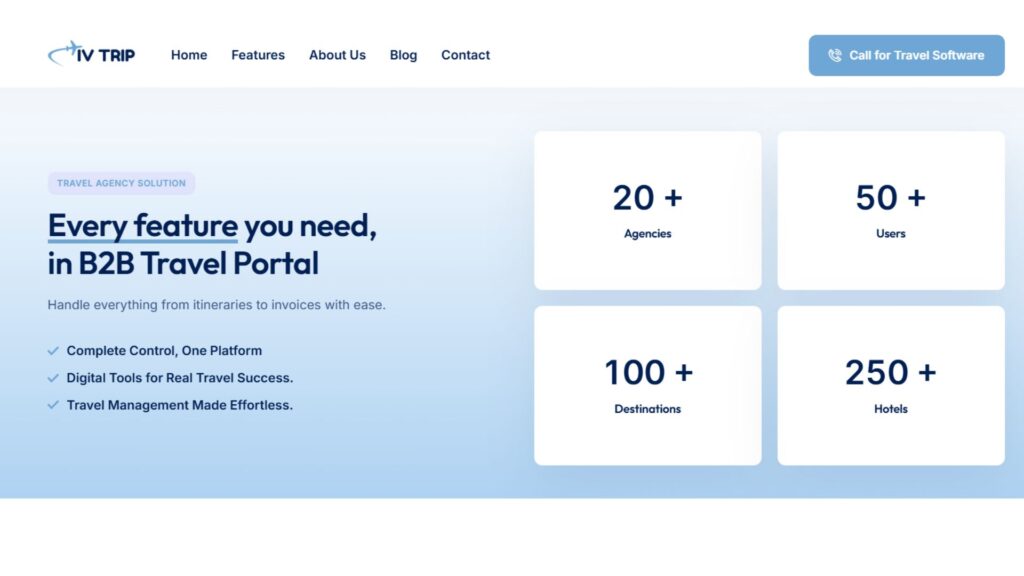 Step 2: Build Your OTA Portal with IV Trip
Step 2: Build Your OTA Portal with IV Trip
Now comes the technical setup. IV Trip provides the core travel portal, so you can focus on branding and content.
- Set Up the Website/App: IV Trip is cloud-hosted and mobile-friendly. You don’t need to install any software. Implevista will give you a web dashboard that forms the backend of your OTA. From there, you can enable a web storefront or even use IV Trip’s mobile app functionality. Ensure your website design is easy to use: apply your logo, brand colors, and travel-focused imagery. The goal is a user-friendly interface. (As one OTA guide puts it, an intuitive, quick-loading interface is crucial since travelers are often time-pressed.) IV Trip’s front-end is already optimized for mobile and fast loading, which is essential since most bookings now happen on phones.
- Inventory and Booking Engines: The heart of an OTA is the live travel inventory. IV Trip integrates with global travel APIs. Using IV Trip’s admin settings, connect to flight GDS (Sabre, Amadeus, Travelport, Mystifly) and hotel engines. This will feed real-time availability into your portal. For example, when a user searches for a flight, IV Trip’s booking engine shows live schedules and prices. The platform syncs data in real time, so booking confirmations come instantly. No need to manually update rates – IV Trip handles that via its XML/JSON API feeds. If you have any local airline or hotel API connections (e.g. a domestic carrier), integrate those too. In practice, customers will see a search interface for flights, hotels, tours, etc., and IV Trip will display live results for each. This live inventory feature is what turns your portal into an OTA.
- Payment Gateway Integration: Set up payment methods so customers can pay online. IV Trip supports popular gateways and local options. In Bangladesh, you can connect bKash, Nagad, or Rocket for mobile payments, as well as local bank payment gateways. For international customers, IV Trip can integrate Stripe and PayPal. Make sure to enable multiple currencies if you plan to sell in USD or other currencies. IV Trip will handle the transaction process securely. In summary, your customers will see various payment options (credit card, e-wallet, etc.), and IV Trip will process those through the linked gateway. Accepting diverse payment methods is key – one industry guide advises supporting credit/debit cards, digital wallets, and multiple currencies.
- Testing Your Portal: Before going live, test every feature. Search and book a few dummy flights and hotels to ensure the inventory comes through correctly. Make test payments (IV Trip has sandbox modes for payment gateways) to verify transactions. Check that confirmation emails and bookings appear as expected. Test on different devices (mobile, tablet, desktop) to ensure the responsive design works. Fix any issues with data feeds or UI before you announce the site.
With the site built and tested, you have a functioning OTA portal: customers can search flights and hotels with live data, pay securely, and receive confirmations instantly. Next, you’ll focus on connecting marketing and CRM to grow your agency.

Step 3: Integrate CRM and Marketing Automation
Attracting and retaining customers requires more than technology – you need effective marketing and customer management. IV Trip’s platform makes this easy by integrating CRM and automation tools.
- CRM Integration: Centralize all customer data in one place. IV Trip’s built-in CRM captures client profiles, booking history, and communications. But you can also link an external CRM (like Microsoft Dynamics 365 or Salesforce) if you prefer. Implevista even specializes in Dynamics 365 implementations, so integrating that with IV Trip is possible. The point is to track every lead and client. With a travel CRM, agents can send personalized offers and follow-ups. According to a travel-software guide, CRM features help agencies “personalize offers, automate follow-ups, and remember repeat clients”, which strengthens loyalty and sales. In practice, once integrated, your IV Trip CRM will let you segment customers (e.g. by destination interest) and send targeted email campaigns automatically. As one CRM expert notes, using a travel CRM yields “better client relations and retention, a stronger brand image, and the automation of many tasks”.
- Marketing Automation: Use automation to handle marketing at scale. IV Trip has built-in tools for email newsletters, booking confirmations, and social promotions. For example, you can automate sending e-tickets or invoices as soon as a booking is confirmed. For lead generation, IV Trip can trigger welcome emails or holiday deals based on customer actions. You should also leverage external channels: connect IV Trip with email services or social ad platforms. The marketing experts at Dotdigital point out that automation saves considerable time by handling repetitive tasks like email blasts and social posts. Similarly, tools like WhatsApp Business API can broadcast deals or answer FAQs instantly – one case study saw a travel agency boost bookings 22% by using a WhatsApp chatbot for instant responses. The key is to set up targeted campaigns (birthdays, loyalty tiers, seasonal offers) and let the system send them automatically.
By integrating CRM and marketing automation, your OTA can nurture leads and keep customers engaged without extra manual work. The result is higher conversion and repeat bookings: one travel CRM report notes that automating follow-ups and segmentation leads to more clients and streamlined communication. With IV Trip handling the heavy lifting, you can focus on strategy rather than spreadsheets.
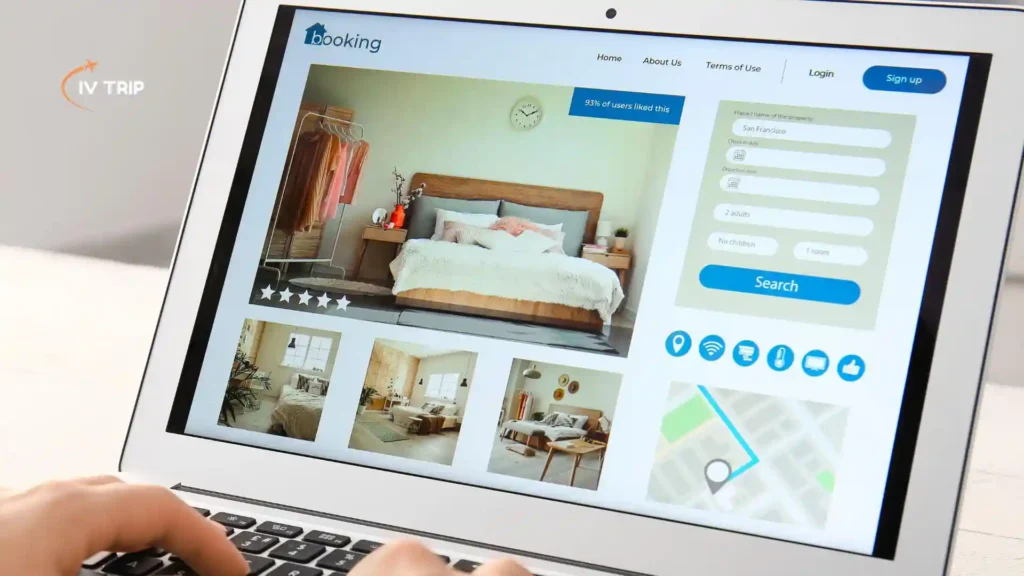
Step 4: Add Content and Packages
With technology in place, fill your OTA with attractive content and packages:
- Populate Inventory: Although IV Trip pulls live data from suppliers, you should curate your own offerings too. Create custom tour packages or promotions (e.g. “3 nights in Cox’s Bazar + sightseeing”) using IV Trip’s itinerary builder. You can combine flights, hotels, and activities into a single package and present it to customers. The platform’s drag-and-drop itinerary tool lets you build multi-day trips easily, automatically calculating prices.
- Local Focus: Highlight Bangladesh destinations to stand out. Include popular local itineraries, visa assistance info, and local deals. According to travel industry research, Bangladeshi tourism is growing, so local content will attract domestic travelers
- Content & SEO: Write clear descriptions and add images for all hotels and tours. This improves SEO (so search engines find your OTA). Use keywords like “online travel agency”, “book flights Bangladesh”, etc., naturally in your page content. Good content will drive organic traffic.
- User Experience: Ensure an easy booking flow. Every search result should have a quick “Book Now” button. Use filtering (dates, price) to help users find deals fast. Remember the advice: “offer a straightforward, multi-step booking process with all pertinent information prominently displayed”. And keep loading speeds fast and UI uncluttered.
Once your content and packages are live, customers will find real value on your site. Remember to test the user journey from search to booking confirmation to ensure it feels seamless.
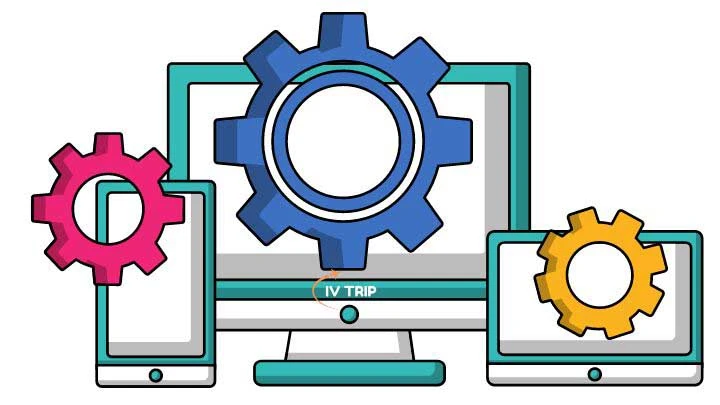
Step 5: Launch, Market, and Optimize
You’re ready to go live! Now, drive traffic to your OTA and continuously improve.
- Launch Promotion: Announce your new OTA portal through social media, email newsletters, and partnerships. Offer a launch discount to first-time bookers or loyalty points for sign-ups. Use IV Trip’s email automation to send promotional blasts to your subscriber list.
- Digital Marketing: Invest in online advertising – Google Ads, Facebook campaigns, and Google Hotel Ads if applicable. According to digital marketing guides, targeted ads combined with SEO can rapidly increase bookings. Track your ad performance via Google Analytics integration in IV Trip.
- WhatsApp Outreach: As one digital strategy suggests, use WhatsApp Business API for high-engagement messages. Send timely flight alerts or last-minute offers via WhatsApp broadcasts to customers who opt in. This channel has a ~98% open rate, far exceeding email.
- Monitor & Analyze: Use IV Trip’s analytics to watch your key metrics (bookings per month, revenue, top destinations). If a package isn’t selling, tweak its price or highlight it on the homepage. Data-driven adjustments are crucial. For example, if IV Trip’s dashboard shows most traffic coming from mobile devices (likely above 80%), ensure your mobile UI is polished.
- Customer Support: Provide top-notch support. IV Trip can log all customer queries in the CRM, so follow up quickly. Happy customers leave good reviews, driving more business. Implevista offers local support around the clock, so if you encounter any tech issues, help is always available.
- Key Takeaways: A successful OTA blends technology and service. With IV Trip, you handle everything – from live GDS inventory to CRM-driven follow-ups – in one platform. By planning carefully, leveraging IV Trip’s features (live booking engine, secure payments, integrated CRM, and automation), and marketing smartly, you’ll have a modern OTA that attracts bookings and grows your travel business.
Conclusion
Building an OTA requires smart planning and the right tools. IV Trip gives you that all-in-one travel platform: real-time flight and hotel booking engines, payment gateway integration, mobile-friendly apps, and built-in CRM/automation. By following the steps above – planning your niche, launching your IV Trip portal, and marketing effectively – you can launch a fully-functioning online travel agency.
Ready to launch your OTA? Contact IvTrip today to discuss your needs or request a demo. Explore our Flight Booking and Hotel Booking feature pages to see the platform in action. Stay updated with travel industry insights by subscribing to the Implevista blog and following our Digital Marketing content. Transform your travel business with IV Trip and start booking online customers immediately!
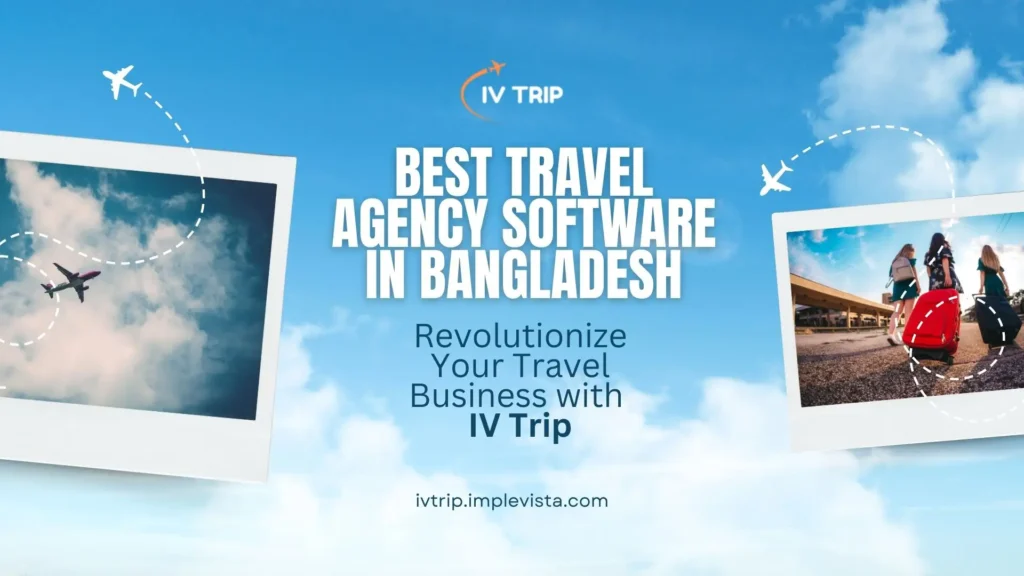
FAQ
Q: What is an Online Travel Agency (OTA)?
A: An OTA is a web-based platform that lets customers book flights, hotels, tours, and other travel services entirely online. It aggregates live inventory from airlines, hotels, etc., so users can compare and book without calling multiple providers. OTAs earn money through supplier commissions and booking fees.
Q: How do I start an OTA with IV Trip?
A: First, plan your business (legal setup, funding, niche). Then sign up for IV Trip. They’ll provision your account and help you configure the system. Next, set up your website or portal using IV Trip’s platform, connect travel APIs for live inventory, and integrate payment gateways. Finally, add content (tours, packages) and launch with marketing. IV Trip’s support team will guide you through each step.
Q: What features should my OTA portal have?
A: At minimum: live flight and hotel booking engines, a secure checkout/payment system, user accounts, and itinerary management. It should also include CRM integration (to capture customer data) and marketing tools (email/notifications). IV Trip provides all of these out of the box – search-and-book features with real-time inventory, multi-currency payment options, an integrated CRM, and automated communications.
Q: How do I integrate live flight and hotel inventory?
A: Use IV Trip’s travel API connections. IV Trip connects to GDS providers (like Amadeus, Sabre, Travelport) and major hotel suppliers via XML/JSON feeds. You simply enable these connections in the IV Trip dashboard. When customers search, IV Trip queries those APIs for real-time availability and pricing. This automation keeps your OTA’s inventory live without manual updates.
Q: How do I set up payments on my OTA?
A: IV Trip supports multiple payment gateways. For example, in Bangladesh you can enable bKash, Nagad, or local bank APIs, and you can also link international gateways like Stripe or PayPal. In IV Trip’s settings, enter your merchant API credentials. The platform will then handle transactions and currency conversion for you. Always use a secure (HTTPS) site and comply with payment regulations.
Q: Why do I need CRM integration for my travel agency?
A: A CRM (Customer Relationship Management) system keeps all your customer data in one place. For travel agencies, this means tracking guest preferences, booking history, and communication. With CRM, you can automate personalized follow-ups, send targeted offers, and improve client loyalty. In fact, agencies report “better client relations and retention” and increased efficiency when using a travel CRM. IV Trip’s built-in CRM or an external CRM integration helps you turn one-time buyers into repeat customers.
Q: What is marketing automation in a travel agency?
A: Marketing automation uses software to run your marketing tasks automatically. For OTAs, this includes automated email campaigns, SMS or WhatsApp broadcasts, and social media posting. For example, you can automatically send a booking confirmation email or a newsletter about new tour deals. This saves time on repetitive tasks. Industry experts note that automation significantly “saves time and resources” by handling bulk emails, social ads, and lead nurturing without manual work.
Q: Is IV Trip mobile-friendly?
A: Yes. IV Trip is fully mobile-responsive. Both agents and customers can use the same platform on smartphones and tablets. The IV Trip interface adapts to small screens, ensuring booking and management features work seamlessly on the go. Given that around 85% of OTA bookings come from mobile devices, having a mobile-friendly system is crucial.
Q: Can small agencies use IV Trip?
A: Absolutely. IV Trip offers tiered subscription plans tailored to agencies of all sizes. Even if you’re a small startup, you can choose a lower-tier plan with essential features. Since it’s cloud-based, there are no large upfront IT costs. IV Trip’s local pricing (in BDT) and support mean small agencies can access powerful features (real-time booking, CRM, etc.) without needing a big budget.
Q: How much does it cost to start an OTA?
A: Costs vary depending on your plans and scale. You’ll need to budget for software and services: IV Trip subscription fees (which depend on your feature package and user count), website development, marketing, and operations. IV Trip’s pricing is subscription-based with local currency options. Many agencies invest only a few lakhs BDT in setup. It’s best to contact IvTrip directly for a quote based on your needs. They can tailor a plan and pricing to fit your budget.
